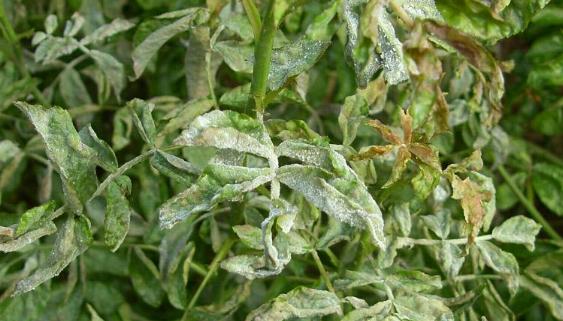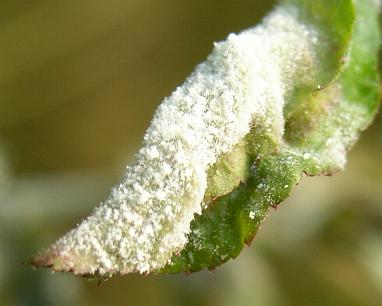POWDERY MILDEW
(Podosphaera leucotricha)

A fungus which appears as a dry powdery
bloom on the upper sides of leaves, usually in hot dry
conditions. Ornamental Malus and fruiting apple trees are
most susceptible to the above species. Other species of powdery mildew effect roses,
peas, gooseberries, vines, strawberries, turnips,
cucumbers and cereals. Ornamental plants
like Chrysanthemums, Michaelmas dasies and Phlox are susceptible.
It survives the winter as mycelia in
the buds, affected buds and smaller twigs have a silvery
appearance. At bud break in the spring the mycelium
emerges and grows on the surface of the young leaves (primary
mildew) producing asexual spores which are carried in the
air, landing on other leaves and developing into
secondary mildew. This growth withdraws moisture and
nutrients causing premature leaf drop and if young fruit
are affected they develop a rough skin - russeting.
Sexual spores may be produced in the autumn, but are not
important for over-wintering on apple trees as it survives
in the buds. The species which infect herbaceous perennial or annual plants spend the winter as sexual spores, ready to attack the new growth.

The white mycelium of Powdery Mildew on the leaf of a rose.
Cultural control in apples is by winter pruning to remove infected buds and open up the tree for good air flow. Other hygeine considerations are important with strawberries and vegetables, ie. removing leaf debris which could overwinter the spores, and good separation of plants. During dry weather keep plants well watered especially roses growing near walls and containerised fruit trees.
A spray of detergent-like fungicide before bud break in apples will prevent development, or use curative spray of Dinocap in summer if mildew develops. Spraying with dispersible sulphur is an allowable organic treatment. There are some home remedies on the Recipes page.
Back to article on Plant Diseases